

Compact Muon Solenoid
LHC, CERN
| CMS-PAS-SMP-21-011 | ||
| Measurement of electroweak production of W$\gamma$ with two jets in proton-proton collisions at $\sqrt{s} = $ 13 TeV | ||
| CMS Collaboration | ||
| May 2022 | ||
| Abstract: A measurement is presented for the electroweak production of a W boson, a photon ($\gamma$), and two jets (j) in proton-proton collisions. The leptonic decay of W boson is selected by requiring one identified electron or muon and a large missing transverse momentum. The two jets are required to have a high dijet mass and a large separation in pseudorapidity. The measurement is performed with the data collected by the CMS detector at a center-of-mass energy of 13 TeV, corresponding to an integrated luminosity of 138 fb$^{-1}$. The cross section for the electroweak W$\gamma$jj production in a restricted fiducial region is 19.2 $\pm$ 4.0 fb, while the inclusive cross section for W$\gamma$jj production in the same fiducial region is 90 $\pm$ 11 fb. Differential cross sections are also measured with the distributions unfolded to the parton level. Constraints are placed on anomalous quartic gauge couplings in terms of dimension-8 effective field theory operators. All results are in agreement with standard model expectations. | ||
|
Links:
CDS record (PDF) ;
Physics Briefing ;
CADI line (restricted) ;
These preliminary results are superseded in this paper, PRD 108 (2023) 032017. The superseded preliminary plots can be found here. |
||
| Figures | |

png pdf |
Figure 1:
Representative Feynman diagrams for the W$\gamma$jj production at the LHC: EW (left), EW through triple (middle left) and quartic (middle right) gauge boson couplings, and QCD-induced (right). |

png pdf |
Figure 1-a:
Representative Feynman diagrams for the W$\gamma$jj production at the LHC: EW (left), EW through triple (middle left) and quartic (middle right) gauge boson couplings, and QCD-induced (right). |
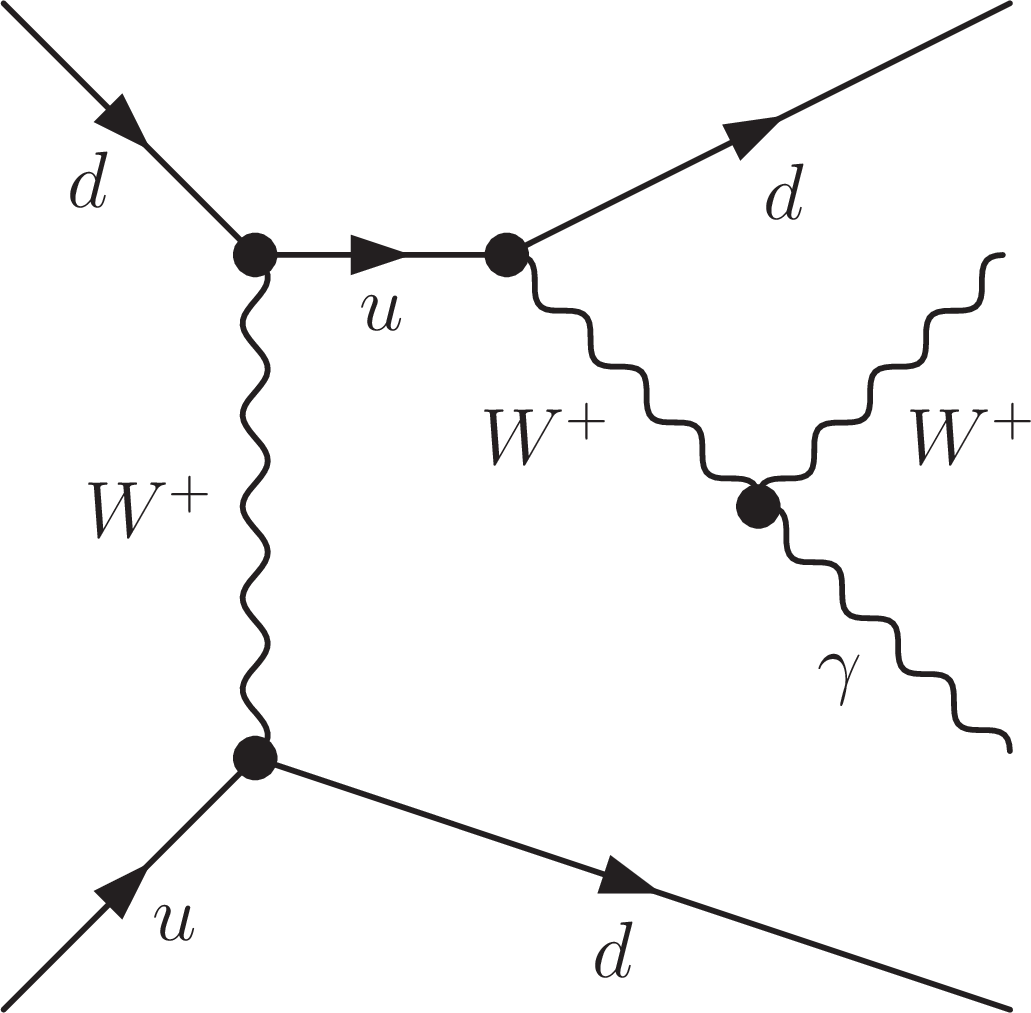
png pdf |
Figure 1-b:
Representative Feynman diagrams for the W$\gamma$jj production at the LHC: EW (left), EW through triple (middle left) and quartic (middle right) gauge boson couplings, and QCD-induced (right). |
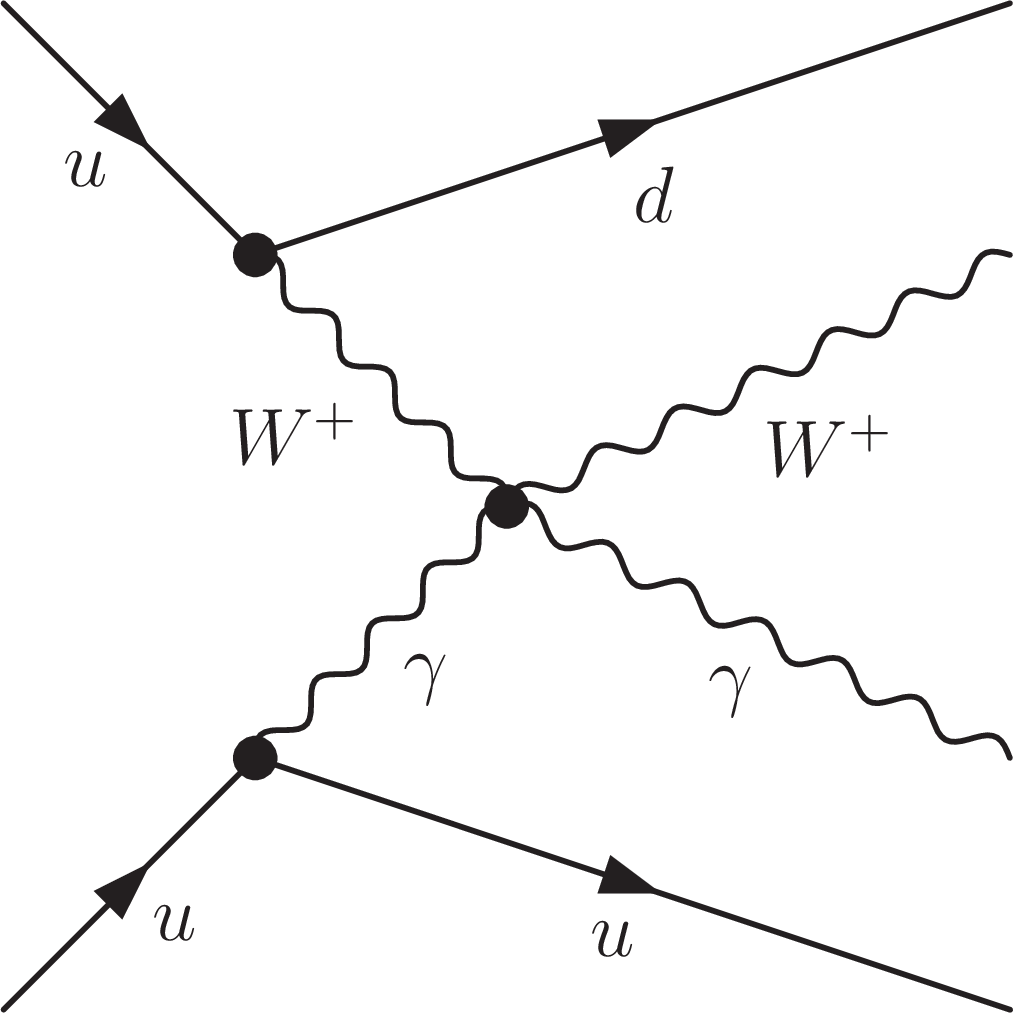
png pdf |
Figure 1-c:
Representative Feynman diagrams for the W$\gamma$jj production at the LHC: EW (left), EW through triple (middle left) and quartic (middle right) gauge boson couplings, and QCD-induced (right). |
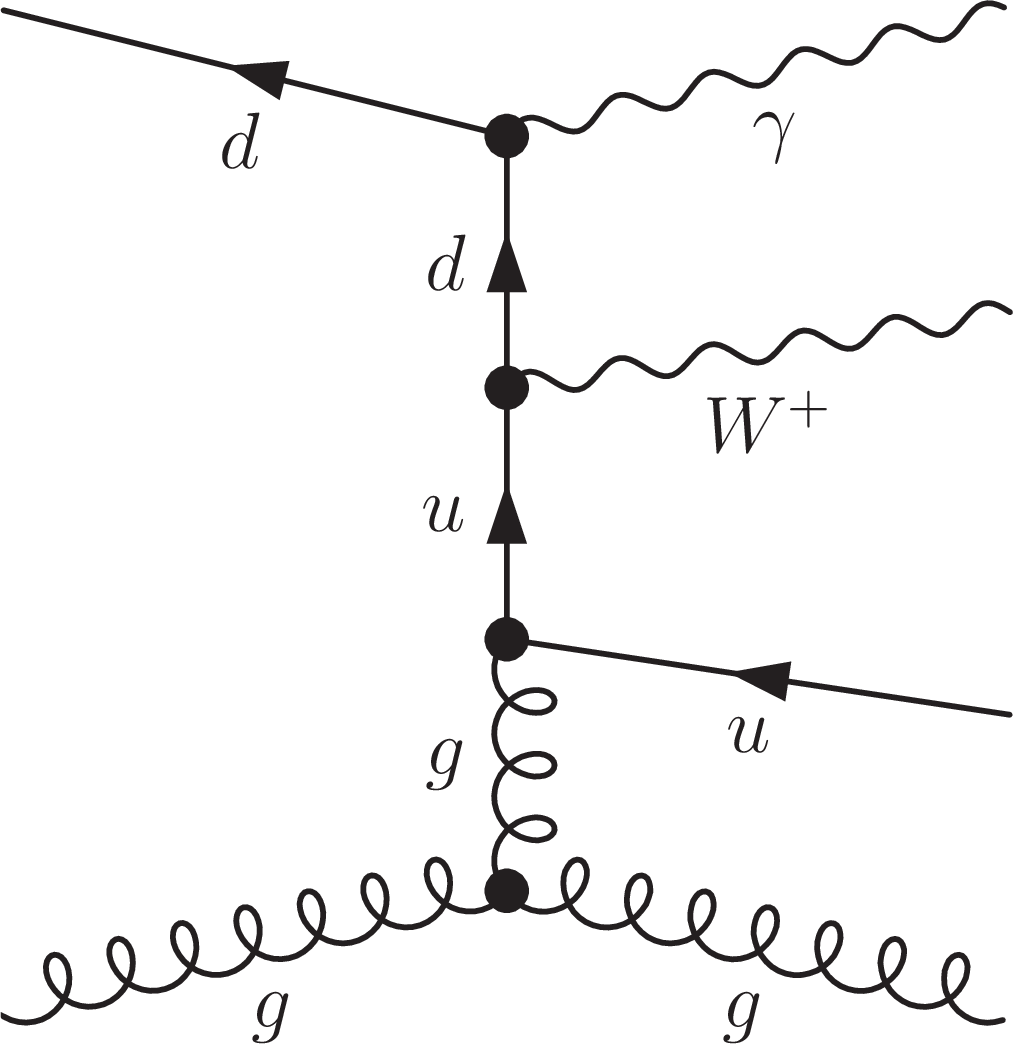
png pdf |
Figure 1-d:
Representative Feynman diagrams for the W$\gamma$jj production at the LHC: EW (left), EW through triple (middle left) and quartic (middle right) gauge boson couplings, and QCD-induced (right). |

png pdf |
Figure 2:
The photon ${p_{\mathrm {T}}}$ distribution in the control region for data and from background estimations before the fit to the data. The misID backgrounds are derived from data, whereas the remaining backgrounds are estimated from simulation. All events with photon $ {p_{\mathrm {T}}} > $ 200 GeV are included in the last bin. The hatched bands represent the combined statistical and systematical uncertainties on the predicted yields. The bottom panels show the ratios of the data to the predicted yields. |
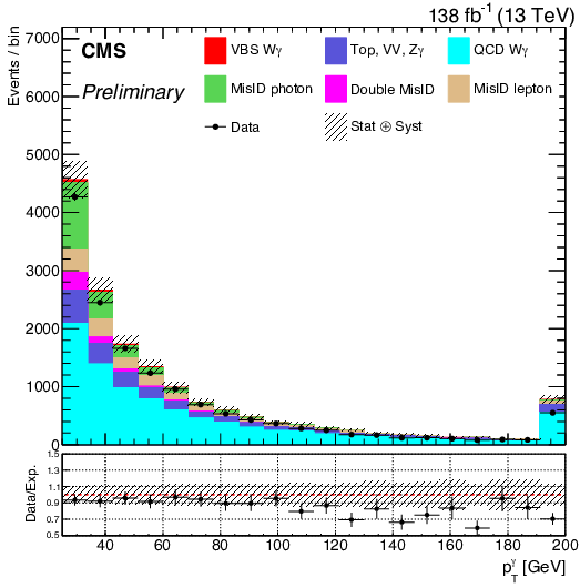
png pdf |
Figure 2-a:
The photon ${p_{\mathrm {T}}}$ distribution in the control region for data and from background estimations before the fit to the data. The misID backgrounds are derived from data, whereas the remaining backgrounds are estimated from simulation. All events with photon $ {p_{\mathrm {T}}} > $ 200 GeV are included in the last bin. The hatched bands represent the combined statistical and systematical uncertainties on the predicted yields. The bottom panels show the ratios of the data to the predicted yields. |

png pdf |
Figure 2-b:
The photon ${p_{\mathrm {T}}}$ distribution in the control region for data and from background estimations before the fit to the data. The misID backgrounds are derived from data, whereas the remaining backgrounds are estimated from simulation. All events with photon $ {p_{\mathrm {T}}} > $ 200 GeV are included in the last bin. The hatched bands represent the combined statistical and systematical uncertainties on the predicted yields. The bottom panels show the ratios of the data to the predicted yields. |
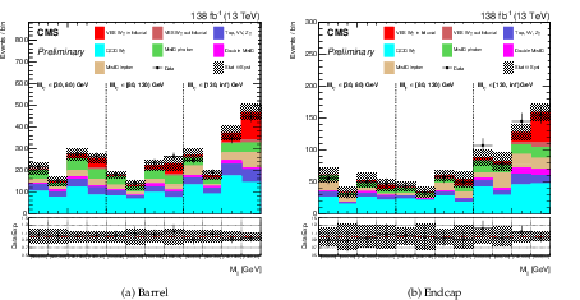
png pdf |
Figure 3:
The 2D distributions used in the fit for the inclusive EW W$\gamma$ cross section measurement. The hatched bands represent the systematic uncertainties on the predicted yields. The predicted yields are shown with their best-fit normalizations. |
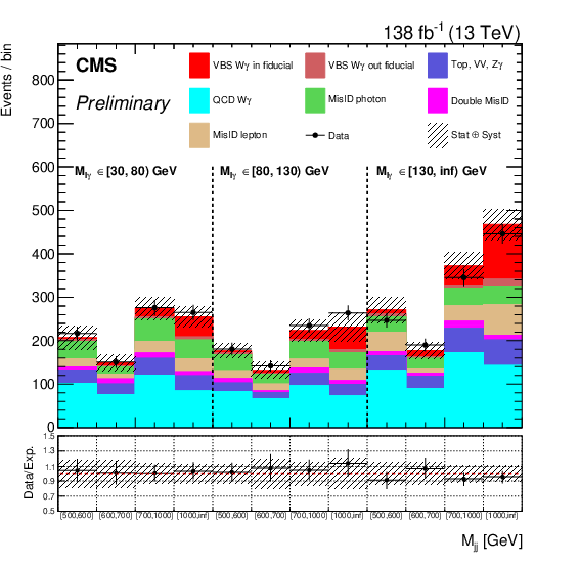
png pdf |
Figure 3-a:
The 2D distributions used in the fit for the inclusive EW W$\gamma$ cross section measurement. The hatched bands represent the systematic uncertainties on the predicted yields. The predicted yields are shown with their best-fit normalizations. |
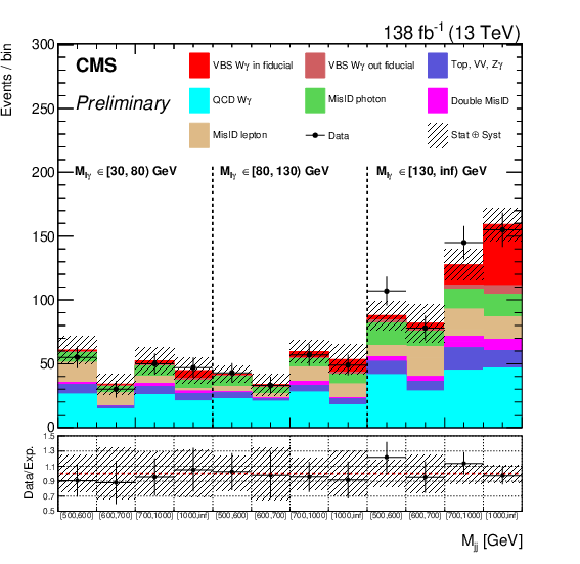
png pdf |
Figure 3-b:
The 2D distributions used in the fit for the inclusive EW W$\gamma$ cross section measurement. The hatched bands represent the systematic uncertainties on the predicted yields. The predicted yields are shown with their best-fit normalizations. |
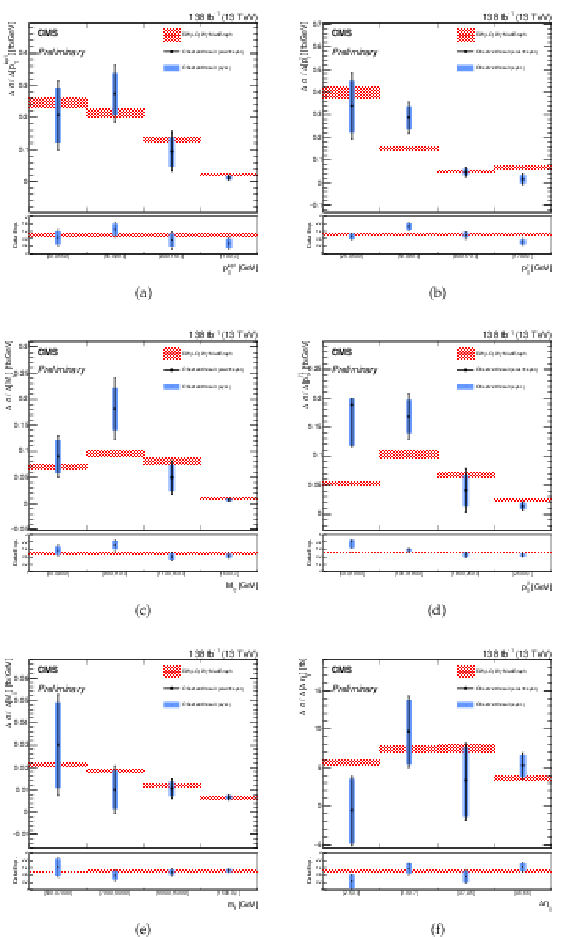
png pdf |
Figure 4:
Differential cross sections for the EW W$\gamma$jj production. Given that the ranges of some variables extend to infinity, the last bins accommodate all the events up to infinity as marked by the bin label, but the bin widths that are used as the denominator are finite and are (110, 400) GeV for ${{p_{\mathrm {T}}} ^{\text {lep1}}}$, (170 200) GeV for ${{p_{\mathrm {T}}} ^{\gamma}}$, (160, 1000) GeV for $m_{\text {l}\gamma}$, (250, 500) GeV for ${{p_{\mathrm {T}}} ^{\text {j1}}}$ and (1500, 2000) GeV for $m_{\text {jj}}$. The blue bands stand for the systematic uncertainties and the black bands include the total uncertainties. |
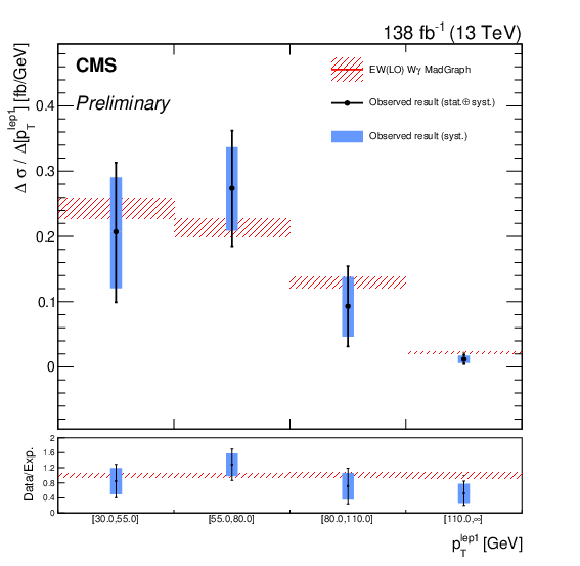
png pdf |
Figure 4-a:
Differential cross sections for the EW W$\gamma$jj production. Given that the ranges of some variables extend to infinity, the last bins accommodate all the events up to infinity as marked by the bin label, but the bin widths that are used as the denominator are finite and are (110, 400) GeV for ${{p_{\mathrm {T}}} ^{\text {lep1}}}$, (170 200) GeV for ${{p_{\mathrm {T}}} ^{\gamma}}$, (160, 1000) GeV for $m_{\text {l}\gamma}$, (250, 500) GeV for ${{p_{\mathrm {T}}} ^{\text {j1}}}$ and (1500, 2000) GeV for $m_{\text {jj}}$. The blue bands stand for the systematic uncertainties and the black bands include the total uncertainties. |

png pdf |
Figure 4-b:
Differential cross sections for the EW W$\gamma$jj production. Given that the ranges of some variables extend to infinity, the last bins accommodate all the events up to infinity as marked by the bin label, but the bin widths that are used as the denominator are finite and are (110, 400) GeV for ${{p_{\mathrm {T}}} ^{\text {lep1}}}$, (170 200) GeV for ${{p_{\mathrm {T}}} ^{\gamma}}$, (160, 1000) GeV for $m_{\text {l}\gamma}$, (250, 500) GeV for ${{p_{\mathrm {T}}} ^{\text {j1}}}$ and (1500, 2000) GeV for $m_{\text {jj}}$. The blue bands stand for the systematic uncertainties and the black bands include the total uncertainties. |

png pdf |
Figure 4-c:
Differential cross sections for the EW W$\gamma$jj production. Given that the ranges of some variables extend to infinity, the last bins accommodate all the events up to infinity as marked by the bin label, but the bin widths that are used as the denominator are finite and are (110, 400) GeV for ${{p_{\mathrm {T}}} ^{\text {lep1}}}$, (170 200) GeV for ${{p_{\mathrm {T}}} ^{\gamma}}$, (160, 1000) GeV for $m_{\text {l}\gamma}$, (250, 500) GeV for ${{p_{\mathrm {T}}} ^{\text {j1}}}$ and (1500, 2000) GeV for $m_{\text {jj}}$. The blue bands stand for the systematic uncertainties and the black bands include the total uncertainties. |

png pdf |
Figure 4-d:
Differential cross sections for the EW W$\gamma$jj production. Given that the ranges of some variables extend to infinity, the last bins accommodate all the events up to infinity as marked by the bin label, but the bin widths that are used as the denominator are finite and are (110, 400) GeV for ${{p_{\mathrm {T}}} ^{\text {lep1}}}$, (170 200) GeV for ${{p_{\mathrm {T}}} ^{\gamma}}$, (160, 1000) GeV for $m_{\text {l}\gamma}$, (250, 500) GeV for ${{p_{\mathrm {T}}} ^{\text {j1}}}$ and (1500, 2000) GeV for $m_{\text {jj}}$. The blue bands stand for the systematic uncertainties and the black bands include the total uncertainties. |

png pdf |
Figure 4-e:
Differential cross sections for the EW W$\gamma$jj production. Given that the ranges of some variables extend to infinity, the last bins accommodate all the events up to infinity as marked by the bin label, but the bin widths that are used as the denominator are finite and are (110, 400) GeV for ${{p_{\mathrm {T}}} ^{\text {lep1}}}$, (170 200) GeV for ${{p_{\mathrm {T}}} ^{\gamma}}$, (160, 1000) GeV for $m_{\text {l}\gamma}$, (250, 500) GeV for ${{p_{\mathrm {T}}} ^{\text {j1}}}$ and (1500, 2000) GeV for $m_{\text {jj}}$. The blue bands stand for the systematic uncertainties and the black bands include the total uncertainties. |
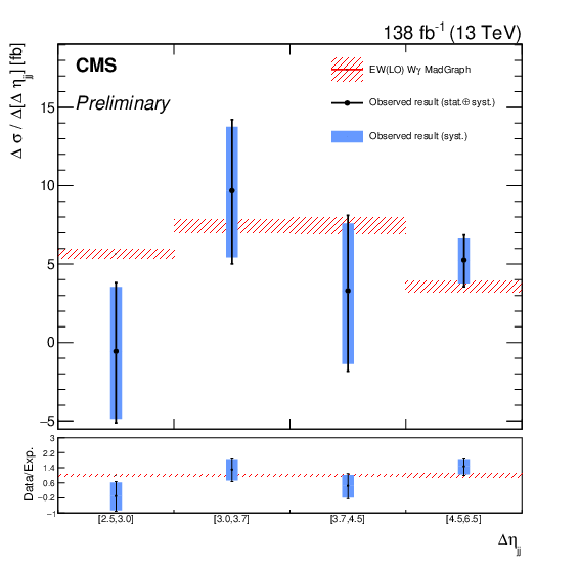
png pdf |
Figure 4-f:
Differential cross sections for the EW W$\gamma$jj production. Given that the ranges of some variables extend to infinity, the last bins accommodate all the events up to infinity as marked by the bin label, but the bin widths that are used as the denominator are finite and are (110, 400) GeV for ${{p_{\mathrm {T}}} ^{\text {lep1}}}$, (170 200) GeV for ${{p_{\mathrm {T}}} ^{\gamma}}$, (160, 1000) GeV for $m_{\text {l}\gamma}$, (250, 500) GeV for ${{p_{\mathrm {T}}} ^{\text {j1}}}$ and (1500, 2000) GeV for $m_{\text {jj}}$. The blue bands stand for the systematic uncertainties and the black bands include the total uncertainties. |

png pdf |
Figure 5:
Differential cross sections for the W$\gamma$jj production. Given that the ranges of some variables extend to infinity, the last bins accommodate all the events up to infinity as marked by the bin label, but the bin widths that are used as the denominator are finite and are (110, 400) GeV for ${{p_{\mathrm {T}}} ^{\text {lep1}}}$, (170 200) GeV for ${{p_{\mathrm {T}}} ^{\gamma}}$, (160, 1000) GeV for $m_{\text {l}\gamma}$, (250, 500) GeV for ${{p_{\mathrm {T}}} ^{\text {j1}}}$ and (1500, 2000) GeV for $m_{\text {jj}}$. The blue bands stand for the systematic uncertainties and the black bands include the total uncertainties. |
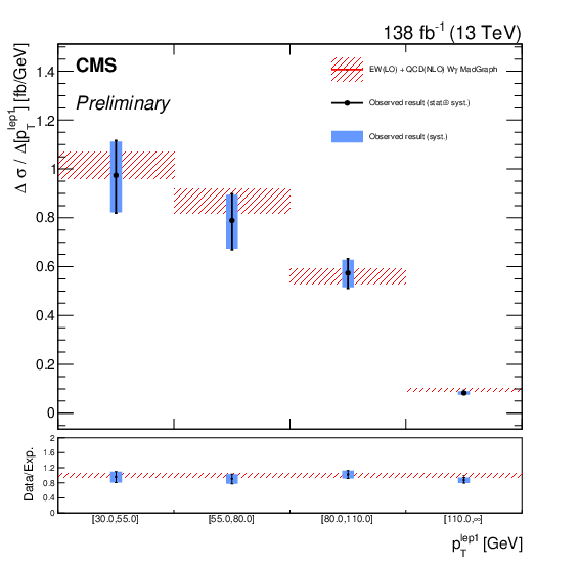
png pdf |
Figure 5-a:
Differential cross sections for the W$\gamma$jj production. Given that the ranges of some variables extend to infinity, the last bins accommodate all the events up to infinity as marked by the bin label, but the bin widths that are used as the denominator are finite and are (110, 400) GeV for ${{p_{\mathrm {T}}} ^{\text {lep1}}}$, (170 200) GeV for ${{p_{\mathrm {T}}} ^{\gamma}}$, (160, 1000) GeV for $m_{\text {l}\gamma}$, (250, 500) GeV for ${{p_{\mathrm {T}}} ^{\text {j1}}}$ and (1500, 2000) GeV for $m_{\text {jj}}$. The blue bands stand for the systematic uncertainties and the black bands include the total uncertainties. |
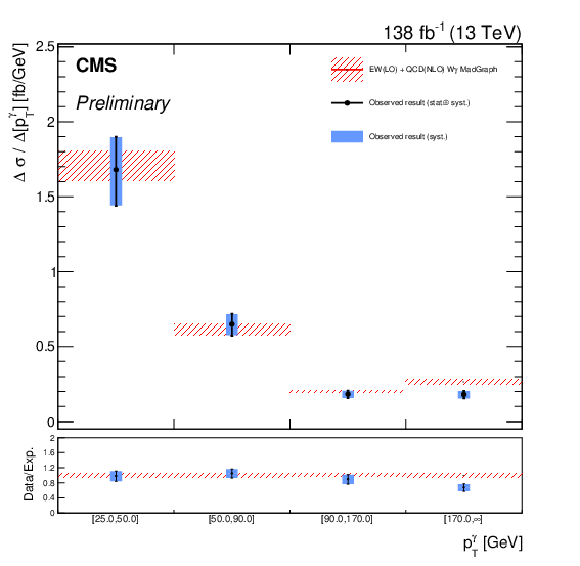
png pdf |
Figure 5-b:
Differential cross sections for the W$\gamma$jj production. Given that the ranges of some variables extend to infinity, the last bins accommodate all the events up to infinity as marked by the bin label, but the bin widths that are used as the denominator are finite and are (110, 400) GeV for ${{p_{\mathrm {T}}} ^{\text {lep1}}}$, (170 200) GeV for ${{p_{\mathrm {T}}} ^{\gamma}}$, (160, 1000) GeV for $m_{\text {l}\gamma}$, (250, 500) GeV for ${{p_{\mathrm {T}}} ^{\text {j1}}}$ and (1500, 2000) GeV for $m_{\text {jj}}$. The blue bands stand for the systematic uncertainties and the black bands include the total uncertainties. |
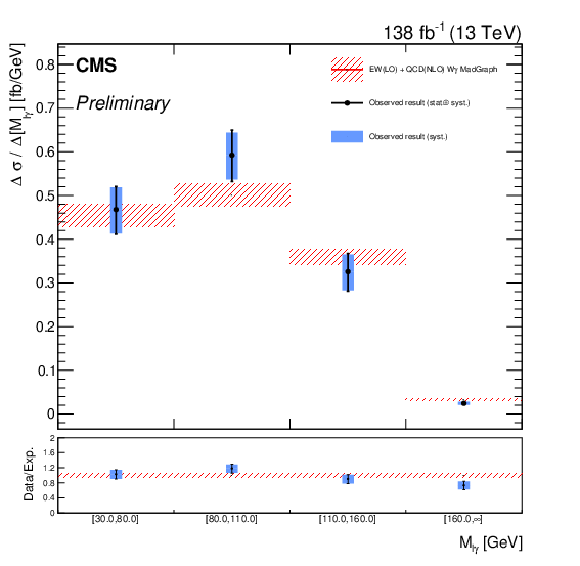
png pdf |
Figure 5-c:
Differential cross sections for the W$\gamma$jj production. Given that the ranges of some variables extend to infinity, the last bins accommodate all the events up to infinity as marked by the bin label, but the bin widths that are used as the denominator are finite and are (110, 400) GeV for ${{p_{\mathrm {T}}} ^{\text {lep1}}}$, (170 200) GeV for ${{p_{\mathrm {T}}} ^{\gamma}}$, (160, 1000) GeV for $m_{\text {l}\gamma}$, (250, 500) GeV for ${{p_{\mathrm {T}}} ^{\text {j1}}}$ and (1500, 2000) GeV for $m_{\text {jj}}$. The blue bands stand for the systematic uncertainties and the black bands include the total uncertainties. |

png pdf |
Figure 5-d:
Differential cross sections for the W$\gamma$jj production. Given that the ranges of some variables extend to infinity, the last bins accommodate all the events up to infinity as marked by the bin label, but the bin widths that are used as the denominator are finite and are (110, 400) GeV for ${{p_{\mathrm {T}}} ^{\text {lep1}}}$, (170 200) GeV for ${{p_{\mathrm {T}}} ^{\gamma}}$, (160, 1000) GeV for $m_{\text {l}\gamma}$, (250, 500) GeV for ${{p_{\mathrm {T}}} ^{\text {j1}}}$ and (1500, 2000) GeV for $m_{\text {jj}}$. The blue bands stand for the systematic uncertainties and the black bands include the total uncertainties. |
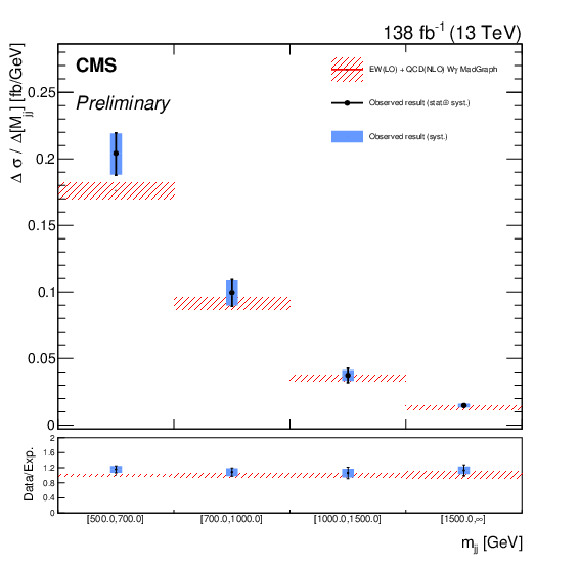
png pdf |
Figure 5-e:
Differential cross sections for the W$\gamma$jj production. Given that the ranges of some variables extend to infinity, the last bins accommodate all the events up to infinity as marked by the bin label, but the bin widths that are used as the denominator are finite and are (110, 400) GeV for ${{p_{\mathrm {T}}} ^{\text {lep1}}}$, (170 200) GeV for ${{p_{\mathrm {T}}} ^{\gamma}}$, (160, 1000) GeV for $m_{\text {l}\gamma}$, (250, 500) GeV for ${{p_{\mathrm {T}}} ^{\text {j1}}}$ and (1500, 2000) GeV for $m_{\text {jj}}$. The blue bands stand for the systematic uncertainties and the black bands include the total uncertainties. |

png pdf |
Figure 5-f:
Differential cross sections for the W$\gamma$jj production. Given that the ranges of some variables extend to infinity, the last bins accommodate all the events up to infinity as marked by the bin label, but the bin widths that are used as the denominator are finite and are (110, 400) GeV for ${{p_{\mathrm {T}}} ^{\text {lep1}}}$, (170 200) GeV for ${{p_{\mathrm {T}}} ^{\gamma}}$, (160, 1000) GeV for $m_{\text {l}\gamma}$, (250, 500) GeV for ${{p_{\mathrm {T}}} ^{\text {j1}}}$ and (1500, 2000) GeV for $m_{\text {jj}}$. The blue bands stand for the systematic uncertainties and the black bands include the total uncertainties. |
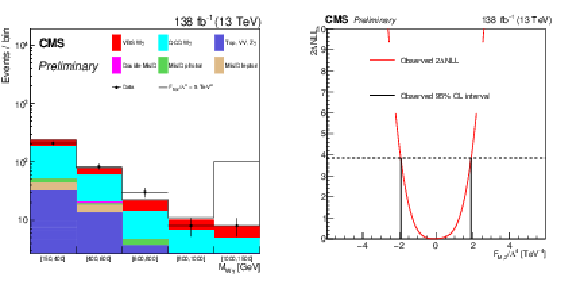
png pdf |
Figure 6:
${m_{{\mathrm{W} \gamma} }}$ distribution for events satisfying the aQGC region selection used to set constraints on the anomalous coupling parameters (left). The gray line represents a nonzero ${f_{\text {M,2}}/\Lambda ^{4}}$ setting. Events with $ {m_{{\mathrm{W} \gamma} }} > $ 1500 GeV are included in the last bin. The hatched bands represent the statistical uncertainties in the predicted yields. Likelihood scan and expected 95% CL interval for the aQGC parameter ${f_{\text {M,2}}/\Lambda ^{4}}$ (right). |

png pdf |
Figure 6-a:
${m_{{\mathrm{W} \gamma} }}$ distribution for events satisfying the aQGC region selection used to set constraints on the anomalous coupling parameters (left). The gray line represents a nonzero ${f_{\text {M,2}}/\Lambda ^{4}}$ setting. Events with $ {m_{{\mathrm{W} \gamma} }} > $ 1500 GeV are included in the last bin. The hatched bands represent the statistical uncertainties in the predicted yields. Likelihood scan and expected 95% CL interval for the aQGC parameter ${f_{\text {M,2}}/\Lambda ^{4}}$ (right). |

png pdf |
Figure 6-b:
${m_{{\mathrm{W} \gamma} }}$ distribution for events satisfying the aQGC region selection used to set constraints on the anomalous coupling parameters (left). The gray line represents a nonzero ${f_{\text {M,2}}/\Lambda ^{4}}$ setting. Events with $ {m_{{\mathrm{W} \gamma} }} > $ 1500 GeV are included in the last bin. The hatched bands represent the statistical uncertainties in the predicted yields. Likelihood scan and expected 95% CL interval for the aQGC parameter ${f_{\text {M,2}}/\Lambda ^{4}}$ (right). |
| Summary |
| The cross section for the electroweak production of a W boson, a photon, and two jets in proton-proton collisions at a center-of-mass energy of 13 TeV is studied. The data correspond to an integrated luminosity of 138 fb$^{-1}$ collected with the CMS detector. Events are selected by requiring one high-${p_{\mathrm{T}}}$ isolated lepton (electron or muon), a moderate missing transverse momentum, one high-${p_{\mathrm{T}}}$ isolated photon, and two jets with a large rapidity separation and a large dijet mass. The observed significance is 6.0 standard deviations, where a significance of 6.8 standard deviations is expected based on standard model predictions. The cross section for the electroweak W$\gamma$jj production in a restricted fiducial region is 19.2 $\pm$ 4.0 fb and the cross section for the total W$\gamma$jj production in the same fiducial region is 90 $\pm$ 11 fb. Both measurements are consistent with standard model predictions. For the first time, differential cross sections for the EW W$\gamma$jj and for the EW+QCD W$\gamma$jj production are measured. Constraints placed on anomalous quartic gauge couplings in terms of dimension-8 effective field theory operators are extracted and found to be competitive with previous results. |
| References | ||||
| 1 | ATLAS Collaboration | Observation of a new particle in the search for the standard model Higgs boson with the ATLAS detector at the LHC | PLB 716 (2012) 1 | 1207.7214 |
| 2 | CMS Collaboration | Observation of a new boson at a mass of 125 GeV with the CMS experiment at the LHC | PLB 716 (2012) 30 | CMS-HIG-12-028 1207.7235 |
| 3 | CMS Collaboration | Observation of a new boson with mass near 125 GeV in pp collisions at $ \sqrt{s}= $ 7 and 8 TeV | JHEP 06 (2013) 081 | CMS-HIG-12-036 1303.4571 |
| 4 | CMS Collaboration | Observation of electroweak production of same-sign W boson pairs in the two jet and two same-sign lepton final state in proton-proton collisions at $ \sqrt{s}=$ 13 TeV | PRL 120 (2018) 081801 | CMS-SMP-17-004 1709.05822 |
| 5 | ATLAS Collaboration | Observation of electroweak production of a same-sign W boson pair in association with two jets in pp collisions at $ \sqrt{s}=$ 13 TeV with the ATLAS detector | PRL 123 (2019) 161801 | 1906.03203 |
| 6 | CMS Collaboration | Measurements of production cross sections of wz and same-sign ww boson pairs in association with two jets in proton-proton collisions at $ \sqrt{s}=$ 13 TeV | Physics Letters B 809 (2020) 135710 | CMS-SMP-19-012 2005.01173 |
| 7 | ATLAS Collaboration | Studies of Z$\gamma$ production in association with a high-mass dijet system in pp collisions at $ \sqrt{s}=$ 8 TeV with the ATLAS detector | JHEP 07 (2017) 107 | 1705.01966 |
| 8 | CMS Collaboration | Measurement of the cross section for electroweak production of Z$\gamma$ in association with two jets and constraints on anomalous quartic gauge couplings in proton-proton collisions at $ \sqrt{s}=$ 8 TeV | PLB 770 (2017) 380 | CMS-SMP-14-018 1702.03025 |
| 9 | CMS Collaboration | Measurement of electroweak-induced production of W$\gamma$ with two jets in pp collisions at $ \sqrt{s}=$ 8 TeV and constraints on anomalous quartic gauge couplings | JHEP 06 (2017) 106 | CMS-SMP-14-011 1612.09256 |
| 10 | CMS Collaboration | Observation of electroweak production of W$ \gamma $ with two jets in proton-proton collisions at $ \sqrt {s} = $ 13 TeV | PLB 811 (2020) 135988 | CMS-SMP-19-008 2008.10521 |
| 11 | CMS Collaboration | Measurement of the cross section for electroweak production of a Z boson, a photon and two jets in proton-proton collisions at $ \sqrt{s} = $ 13 TeV and constraints on anomalous quartic couplings | Journal of High Energy Physics 06 (2020) 076 | CMS-SMP-18-007 2002.09902 |
| 12 | V. A. Khoze, M. G. Ryskin, W. J. Stirling, and P. H. Williams | A Z-monitor to calibrate Higgs production via vector boson fusion with rapidity gaps at the LHC | EPJC 26 (2003) 429 | hep-ph/0207365 |
| 13 | C. Oleari and D. Zeppenfeld | QCD corrections to electroweak $ \ell\nu$jj and $ \ell^{+}\ell^{-}$jj production | PRD 69 (2004) 093004 | hep-ph/0310156 |
| 14 | C. Degrande et al. | Effective field theory: A modern approach to anomalous couplings | Ann. Phys. 335 (2013) 21 | 1205.4231 |
| 15 | CMS Collaboration | The CMS experiment at the CERN LHC | JINST 3 (2008) S08004 | CMS-00-001 |
| 16 | CMS Collaboration | The CMS trigger system | JINST 12 (2017) P01020 | CMS-TRG-12-001 1609.02366 |
| 17 | J. Alwall et al. | The automated computation of tree-level and next-to-leading order differential cross sections, and their matching to parton shower simulations | JHEP 07 (2014) 079 | 1405.0301 |
| 18 | R. Frederix and S. Frixione | Merging meets matching in MC@NLO | JHEP 12 (2012) 061 | 1209.6215 |
| 19 | T. Sjostrand et al. | An introduction to PYTHIA 8.2 | CPC 191 (2015) 159 | 1410.3012 |
| 20 | P. Nason | A New method for combining NLO QCD with shower Monte Carlo algorithms | JHEP 11 (2004) 040 | hep-ph/0409146 |
| 21 | S. Frixione, P. Nason, and C. Oleari | Matching NLO QCD computations with Parton Shower simulations: the POWHEG method | JHEP 11 (2007) 070 | 0709.2092 |
| 22 | R. Frederix, E. Re, and P. Torrielli | Single-top t-channel hadroproduction in the four-flavour scheme with POWHEG and aMC@NLO | JHEP 09 (2012) 130 | 1207.5391 |
| 23 | S. Alioli, P. Nason, C. Oleari, and E. Re | NLO single-top production matched with shower in POWHEG: s- and t-channel contributions | JHEP 09 (2009) 111 | 0907.4076 |
| 24 | E. Re | Single-top Wt-channel production matched with parton showers using the POWHEG method | EPJC 71 (2011) 1547 | 1009.2450 |
| 25 | P. Skands, S. Carrazza, and J. Rojo | Tuning PYTHIA 8.1: the Monash 2013 tune | EPJC 74 (2014) 3024 | 1404.5630 |
| 26 | CMS Collaboration | Event generator tunes obtained from underlying event and multiparton scattering measurements | EPJC 76 (2016) 155 | CMS-GEN-14-001 1512.00815 |
| 27 | NNPDF Collaboration | Parton distributions for the LHC Run II | JHEP 04 (2015) 040 | 1410.8849 |
| 28 | GEANT4 Collaboration | GEANT4 --- a simulation toolkit | NIMA 506 (2003) 250 | |
| 29 | CMS Collaboration | Measurement of the inclusive W and Z production cross sections in pp collisions at $ \sqrt{s}=$ 13 TeV | JHEP 10 (2011) 132 | CMS-EWK-10-005 1107.4789 |
| 30 | CMS Collaboration | Particle-flow reconstruction and global event description with the CMS detector | JINST 12 (2017) P10003 | CMS-PRF-14-001 1706.04965 |
| 31 | CMS Collaboration | Description and performance of track and primary-vertex reconstruction with the CMS tracker | JINST 9 (2014) P10009 | CMS-TRK-11-001 1405.6569 |
| 32 | M. Cacciari, G. P. Salam, and G. Soyez | The anti-$ {k_{\mathrm{T}}} $ jet clustering algorithm | JHEP 04 (2008) 063 | 0802.1189 |
| 33 | M. Cacciari, G. P. Salam, and G. Soyez | FastJet user manual | EPJC 72 (2012) 1896 | 1111.6097 |
| 34 | CMS Collaboration | Performance of electron reconstruction and selection with the CMS detector in proton-proton collisions at $ \sqrt{s}=$ 8 TeV | JINST 10 (2015) P06005 | CMS-EGM-13-001 1502.02701 |
| 35 | CMS Collaboration | Energy calibration and resolution of the CMS electromagnetic calorimeter in pp collision at $ \sqrt{s}=$ 7 TeV | JINST 8 (2013) P09009 | CMS-EGM-11-001 1306.2016 |
| 36 | CMS Collaboration | Performance of the CMS muon detector and muon reconstruction with proton-proton collisions at $ \sqrt{s}= $ 13 TeV | JINST 13 (2018) P06015 | CMS-MUO-16-001 1804.04528 |
| 37 | CMS Collaboration | Performance of the reconstruction and identification of high-momentum muons in proton-proton collisions at $ \sqrt{s}=$ 13 TeV | JINST 15 (2020) P02027 | CMS-MUO-17-001 1912.03516 |
| 38 | M. Cacciari and G. P. Salam | Pileup subtraction using jet areas | PLB 659 (2008) 119 | 0707.1378 |
| 39 | CMS Collaboration | Performance of photon reconstruction and identification with the CMS detector in proton-proton collisions at $ \sqrt{s}=$ 8 TeV | JINST 10 (2015) P08010 | CMS-EGM-14-001 1502.02702 |
| 40 | CMS Collaboration | Determination of jet energy calibration and transverse momentum resolution in CMS | JINST 6 (2011) P11002 | CMS-JME-10-011 1107.4277 |
| 41 | CMS Collaboration | Jet performance in pp collisions at $ \sqrt{s}=$ 7 TeV | CDS | |
| 42 | CMS Collaboration | Performance of missing transverse momentum reconstruction in proton-proton collisions at $ \sqrt{s}=$ 13 TeV using the cms detector | JINST 14 (2019) P07004 | |
| 43 | D. Rainwater, R. Szalapski, and D. Zeppenfeld | Probing color singlet exchange in Z+2-jet events at the CERN LHC | PRD 54 (1996) 6680 | hep-ph/9605444 |
| 44 | Particle Data Group, M. Tanabashi et al. | Review of particle physics | PRD 98 (2018) 030001 | |
| 45 | CMS Collaboration | Search for a heavy resonance decaying to a pair of vector bosons in the lepton plus merged jet final state at $ \sqrt{s}=$ 13 TeV | JHEP 05 (2018) 088 | CMS-B2G-16-029 1802.09407 |
| 46 | CMS Collaboration | Measurement of W$\gamma$ and Z$\gamma$ production in pp collisions at $ \sqrt{s}=$ 7 TeV | PLB 701 (2011) 535 | CMS-EWK-10-008 1105.2758 |
| 47 | CMS Collaboration | Precision luminosity measurement in proton-proton collisions at $ \sqrt{s} = $ 13 TeV in 2015 and 2016 at CMS | EPJC 81 (2021) 800 | CMS-LUM-17-003 2104.01927 |
| 48 | CMS Collaboration | CMS luminosity measurement for the 2017 data-taking period at $ \sqrt{s} = $ 13 TeV | CMS-PAS-LUM-17-004 | CMS-PAS-LUM-17-004 |
| 49 | CMS Collaboration | CMS luminosity measurement for the 2018 data-taking period at $ \sqrt{s} = $ 13 TeV | CMS-PAS-LUM-18-002 | CMS-PAS-LUM-18-002 |
| 50 | J. Butterworth et al. | PDF4LHC recommendations for LHC Run II | JPG 43 (2016) 023001 | 1510.03865 |
| 51 | S. S. Wilks | The large-sample distribution of the likelihood ratio for testing composite hypotheses | Ann. Math. Statist. 9 (1938) 60 | |
| 52 | G. Cowan, K. Cranmer, E. Gross, and O. Vitells | Asymptotic formulae for likelihood-based tests of new physics | EPJC 71 (2011) 1554 | 1007.1727 |
| 53 | O. J. P. Éboli, M. C. Gonzalez-Garcia, and J. K. Mizukoshi | $ {pp}\to \mathrm{jj}{\mathrm{e^{\pm}}\mu^{\pm}\nu\nu} $ and $ \mathrm{jj}\mathrm{e^{\pm}}\mu^{-}p\nu\nu $ at $ \mathcal{O}(\alpha^6_\mathrm{em}) $ and $ \mathcal{O}(\alpha_\mathrm{em}^4 \alpha_\mathrm{s}^2) $ for the study of the quartic electroweak gauge boson vertex at CERN LHC | PRD 74 (2006) 073005 | hep-ph/0606118 |
| 54 | B. Biedermann, A. Denner, and M. Pellen | Large electroweak corrections to vector boson scattering at the Large Hadron Collider | PRL 118 (2017) 261801 | 1611.02951 |
| 55 | B. Biedermann, A. Denner, and M. Pellen | Complete NLO corrections to W$ ^{+} $W$ ^{+} $ scattering and its irreducible background at the LHC | JHEP 10 (2017) 124 | 1708.00268 |
| 56 | E. d. S. Almeida, O. J. P. Éboli, and M. C. Gonzalez-Garcia | Unitarity constraints on anomalous quartic couplings | PRD 101 (2020), no. 11, 113003 | 2004.05174 |

|
Compact Muon Solenoid LHC, CERN |

|

|

|

|

|

|